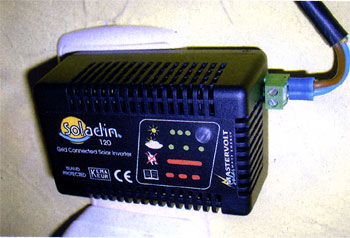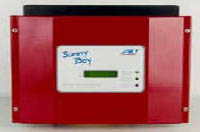For a brief summary of power inverters and their use in a renewable energy systemIntroduction to Inverters.
If you have a small scale renewable energy set up - for example, just a micro wind turbine or a few PV solar panels, then you will almost certainly be using battery storage rather than tying into the National Grid. In those cases there are very many suitable inverters ranging from just £10 to many £hundreds depending on your exact needs. If however you wish to connect your wind turbines and/or solar panels to the National Grid, you will need a Grid-tie Inverter - particularly if you intend to sell (export) electricity back to the utility company.
please read our
Grid-Tie Inverters (plug in type)
Not all grid-tie inverters operate in the same way. In general a grid tie inverter needs to be wired directly into your home electric circuit by a qualified electrician. However a simpler alternative been on the rise recently - an inverter which you simply plug into a home ring main using a standard three pin plug. This is exactly the type of power inverter provided with the popular Windsave 1000 wind turbine from B & Q.If for example you have a laptop computer and a desk lamp drawing around 150 Watts between them, and a solar panel generaing 200 Watts which is plugged into the same ring main using a plug-in inverter, then the laptop and lamp would be powered entirely by your solar panel and any excess power would be lost to the National Grid. If you only had a 100 Watt solar panel, then its power would be supplemented by the National Grid (and you would have to pay for the extra electricity used).

If you have a small DIY renewable energy set up, then a plug in inverter such as the Mastervolt Soladin 120 pictured above is a good starting point. This tiny plug-in inverter will accept up to 2.8A and 50V DC with a nominal power output of up to 90 Watts. It converts the DC into 230 VAC at 90+% efficiency. (12V solar panels would have to be put in series to generate 24 Volts since the voltage range for this inverter starts at 24 VDC.) It is priced at around £100.
Grid-Tie Inverters
Grid-tie inverters are generally one of the most expensive components of a renewable energy generation system. Typically prices start from at least £500, but prices are falling as the technology improves.Manufacturers of quality grid-tie inverters include: ExelTech, Fronius, Magnum Energy, Morningstar, Outback, SMA, Solectria, and Xantrex.

Probably the most popular are the Sunny Boy series of grid connecting inverters from SMA - a German company specialising in inverters for solar generating applications. All Sunny Boy inverters comply with UK G83 grid connection regulations, have efficiencies of over 93%, and have an estimated lifetime of over 20 years.
The SB700 is available in the UK for around £800 offering up to 700 Watts of power. Much larger applications could be served with an SB3000 or SB6000 inverter for powers of up to 3000 (£1500) and 6000 Watts (£2500) respectively. And of course there are Sunny Boy's with many other power outputs within that range.
http://www.reuk.co.uk/Grid-Tie-Inverters.htm